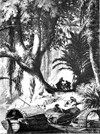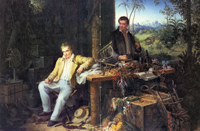Meeting 6 • 23 January 2014
|
Version: |
|
pictures of the week
|
|
|
|
mini-text of the week (start): "The farm we lodged at was a fine sugar-cane plantation.… The owner's house is situated on a hillock surrounded by huts for the negroes.…"Humboldt, "Personal Narrative", from Jaguars and Electric Eels, ed. & trans. Wilson, p. 22 (read more) |
portraits of AvH; work sample: "Leaving Home"; apps related to navigation; 2013 projects
|
(05')√ Thought-bite of the week: Data points vs data ranges: |----•----| What they knew then, what we know now (and how much of what we know now is based on incorrect knowledge). How errors of measurement magnify (example: astronomy) - a recent article about such (Economist magazine, see handout for meeting #5, especially final paragraphs about extrapolation) |
|
(5')√ Mini-text of the week: The tricky topic of slavery - 1) Could free people create a viable economy in the tropics? 2) Review of a book about slavery (Economist magazine, see handout for today), as an example related to the upcoming book review assignment (reading to begin soon - after we know your subject-area interests) |
|
(15')√ Continuation of quantitative activity and expansion to applications related to travel, exploration, and sustainability (basic quantities worksheet, stage 2 • later: basic quantities worksheet stage 3 • basic quantities worksheet stage 4). Comment: Last week people filled in a fair amount of quantities, but indicated very little about how they actually determined those quantities (whether by showing calculations or by giving the sources of their information, for example "personal experience on a flight" or "remembered from middle school math"). The LONGITUDE problem - key to understanding accuracy of mapping and, therefore, recording geophysical data, including weather/climate and biology. Why the need for accurate clocks on board and in the wild? Seat-of-pants calculation: How many miles to a degree of longitude at PDX's latitude (~45 degrees)? Idle airplane speculation: if we're flying back to PDX from NYC, starting at sundown in NYC, will our plane fly fast enough that the sun will appear not to go down at all during our flight? Now a hands-on experience to get the feel of trying to navigate 1800-style (but with instruments much more primitive than theirs): taking a sky-sighting on a rolling ship. But first: How closely can we estimate, with our bodies, degrees of angle? And a "rule of thumb" for doing that. So how wide (in degrees) is the moon as seen from Earth? Why does it "look" so much bigger? Advanced version: If you're at Cannon Beach saluting the beautiful sunset with a favorite person and beverage, how long ago might your friends in PDX might have been doing the same? A look at some mobile apps (here: iPhone/iPad) about navigation and measurement. We'll use some of them later to measure heights and distances. |
|
(15')√ Preview of SINQing the Humboldt canoe, so that we can then load it and travel safely in it. 1) "Brute force" solution: actually sinking a similar canoe - will try to arrange it; 2) "Semi-Brute Force Solution: "dry dock" simulation using Laura Dassow Well's description of Humboldt's canoe and its cargo of people, equipment, and various critters- we'll do that right in the classroom; 3) "Smart Person Solution": saving time and sweat by (e-)pencil-and-paper calculation of volume and "ball park" estimation of weight and displacement. Maybe: Worksheet about volume, weight, and displacement |
|
(05')√ Time limit to be strictly observed, since these topics will come up again): Where are we going from here? What about writing assignments, the book review, the projects? Writing #3 (about your education) starts today and prepares you for projects (and rest of life). Midterm will be at end of week 5. Writing #4 (Humboldt-related species) starts at end of week 5, after you have learned enough to understand the assignment. Writing #5 (book review) starts next week, after we have enough info about your interests to help you find a book. Serious group project work starts with meeting #10. Examples, with their scores/grades, will be (have already been!) provided, and the activities will be discussed in mentor sessions and in class. Here (thanks JE!) is one entertaining example of a group project about food in olden times. You could do worse than convert that into a Humboldt-related project. About grades: AmAze me. Now for the next activities/ assignments and how they related to the larger course goals. |
|
(05')N About Humboldt-named schools and their role in this course; featured schools: PDX (now closed - summer of 2012), Arizona, CA (Humboldt BAY HS), Illinois (AvH Chicago), NYC, Saskatchewan, Mexico City, Puebla, Berlin-Tegel, Hamburg, Rüsselsheim, Kazakhstan; reinterpreting the past better for ourselves by (re)interpreting it for others. Upcoming: choosing your Humboldt-named school as source of info about education and possible beneficiary of your project(s). |
|
(10')+ presentation about educational standards and their parts in the course: 1) evaluating own education; 2) helping others to learn; preview of upcoming writing assignment and skills questionnaire. Documents: Oregon preK-12 standards for Visual & Performing Arts (0693), especially pp. 8-10, 12, 14, & (especially) 26 (see handout for meeting #5). Discussion topic: which standards were addressed by writing about the Humboldt portrait? |
|
(5')+ Wrapup: The Weitsch portait of AvH - relation to long tradition of portrait painting (and photography, including the pics you take of yourselves to express your identity/ies); the emergence of the scholar/ scientists as claimed co-equal of the ruler, churchman, soldier. |
|
(05')N about writing skills and critical thinking: ways to structure "Leaving Home" (abstract>specific, specific>abstract, only specific and let reader figure out the point); work sample (see handout from meeting #3); importance of a concept of change (in our individual lives, in development of human thought - was that concept always around? -, in study of origins of sustainable environmentalism). Some words/ phrases that can undermine your writing: multiple, pertaining, prior to, I think, in my opinion, and '-ing" (Prior to leaving my home> Before I left home OR I did x. Then I left home. OR I left home Before I left, I …) |
|
(0') Start reading these on your own time: Previews & announcements:1) Note how I have annotated the outlines for previous meetings with comments (key to symbols) about what happened during them; 2) Portraits of ourselves as environmentalist-explorers. 3) Upcoming: choosing areas of specialization for individual reading, lesson-plan project, team project. 4) Keeping up with the reading – see "schedule" page; maps now available; pagination of printed vs. e-books. 5) a leftover from the Hawaiian trip - while you're thinking about such things as chocolate, macadamis nuts, and coffee, look at Jaguars and Electric Eels (p. 21) and these links (link 1 • link 2) to see how modern AvH was in his beverages, and read Jaguars p. 44 about his fashionable food interests. 6) Soon we'll load and crew a mockup Humboldt Canoe - still thinking about SINQing a |

